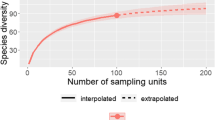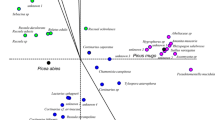Abstract
Fungal communities in the rhizospheres of oak roots were shown to change after the trees were felled. The ecological significance of this is considered. Fungal communities were isolated from rhizospheres of thin roots (0.5–1 mm diam.) of living trees and their stumps two years after felling in 30- and 50-year-old stands of Quercus robur, with samples taken at two locations in each stand. In total, 128 species of fungi were isolated. Six species, Absidia cylindrospora, Penicillium adametzii, P. citrinum, P. daleae, P. janczewskii and Umbelopsis vinacea were detected in the rhizospheres of living oaks and stumps at all locations. The abundance of Geomyces spp. + Pseudogymnoascus roseus, Gymnoascus reessii and Zygomycetes was greater, and of Penicillium spp. was smaller, usually significantly, in rhizospheres of stump roots than of living tree roots. Among Zygomycetes, the populations of A. cylindrospora and Mucor hiemalis decreased, while those of Mortierella spp., particularly M. macrocystis, increased after felling. Species of Penicillium favoured by roots are P. adametzii, P. citrinum, P. daleae, P. herquei, P. janczewskii, P. raistrickii. On stump roots they are replaced by P. chrysogenum, P. islandicum and P. spinulosum. The combination of Chalara spp. with oak roots indicates the occurrence of specific relationships, suggesting that the organic food base provided by the plant is a primary factor determining the composition of the fungal community. Edaphic and other environmental factors may be less important in this effect.
Similar content being viewed by others
References
Atkinson D 1985 Spatial and temporal aspects of roots distribution as indicated by the use of a root observation laboratory. In Ecological Interactions in Soil. <nt>Ed.</nt> A H Fitter. pp. 43–65. Blackwell Scientific Publications, Oxford.
Badurowa M and Badura L 1968 A comparative study on the occurrence of microscopic fungi on leaves and needles from different species of trees growing within the reserve 'Kamien Pomorski'. Ekol. Pol. 26, 253–260.
Bateman J L and Kwasna H 1999 Effects of number of winter wheat crops grown successively on fungal communities on wheat roots. App. Soil Ecol. 13, 271–282.
Bailey R W 1965 Oligosacharides. Pergamon Press. Oxford.
Bååth E B and Söderström E 1980 Degradation of macromolecules by microfungi isolated from different podzolic soil horizons. Can. J. Bot. 58, 422–425.
Chakravarty P and Hwangs S F 1991 Effect of ectomycorrhizal fungus Laccaria laccata on Fusarium damping-off in Pinus banksiana seedlings. Eur. J. For. Path. 21, 97–106.
Chakravarty P and Mishra R R 1986 The influence of vesicular-arbuscular mycorrhizae on the wilting of Albiza procera and Dalbergia sissoo. Eur. J. For. Path. 16, 91–97.
Chakravarty P, Peterson R L and Ellis B 1991 Interaction between the ectomycorrhizal fungus Paxillus involutus, damping-off fungi and Pinus resinosa seedlings. J. Phytopath. 132, 207–218.
Chakravarty P and Unestam T 1987 Mycorrhizal fungi prevent disease in stressed pine seedlings. J. Phytopath. 118, 335–340.
Christensen M 1969 Soil microfungi of dry to mesic coniferhardwood forests in Northern Wisconsin. Ecology 50, 9–27.
Cowley G T and Whittingham W F 1961 The effect of tannin on the growth of selected soil microfungi in culture. Mycologia 53, 539–542.
Curl E A and Truelove B 1986 The rhizosphere. Springer-Verlag, New York Inc., New York.
Dalpe J 1986 Axenic synthesis of ericoid mycorrhiza in Vaccinium angustifolium Ait. by Oidiodendron species. New Phytol. 103, 291–390.
Domsch K H, Gams W and Anderson T-H 1980 Compendium of soil fungi. Academic Press, London.
Douglas G C, Heslin M C and Reid C 1989 Isolation of Oidiodendron maius from Rhododendron and ultrastructural characterization of synthesized mycorrhizas. Can. J. Bot. 67, 2206–2212.
Duchesne L C, Peterson R L and Ellis B E 1988 Interaction between the ectomycorrhizal fungus Paxilus involutus and Pinus resinosa induces resistance to Fusarium oxysporum. Can. J. Bot. 66, 558–562.
Gams W 1961 Eine neue Mortierella aus dem zentralalpinen Rohhumus. Nova Hedwigia 3, 69–71.
Gaspar M L, Cunningham M, Pollero R and Cabello M 1999 Occurrence and properties of an extracellular lipase in Mortierella vinacea. Mycologia 91, 108–113.
Greyston S J 2000 Rhizodeposition and its impact on microbial community structure and functions in trees. Phyton 40, 27–36.
Hambleton S and Currah R S 1997 Fungal endophytes from the roots of alpine and boreal Ericaceae. Can. J. Bot. 75, 1570–1581.
Harrison A F 1971 The inhibitory effect of oak leaf litter tannins on the growth of fungi in relation to litter decomposition. Soil Biol. Biochem. 3, 167–172.
Holubová-Jechová V 1984 Lignicolous hyphomycetes from Czechoslovakia. 7. Chalara, Exochalara, Fusichalara and Dictyochaeta. Folia Geobot. Phytotax. 19, 387–438.
Buyer J S, Roberts D P and Russek-Cohen E 2002 Soil and plant effects on microbial community structure. Can. J. Microbiol. 48, 955–964.
Karinbaeva L Y and Sizova T P 1974 Antagonistic properties of fungi from rhizosphere of certain trees. Mikologiya i Fitopatologiya 8, 474–478.
Kile G A and Walker J 1987 Chalara australis sp. nov. (Hyphomycetes), a vascular pathogen of Nothofagus cunninghamii (Fagaceae) in Australia and its relationship to other Chalara species. Aust. J. Bot. 35, 1–32.
Kowalski T and Halmschlager E 1996 Chalara angustata sp. nov. from roots of Quercus petraea and Quercus robur. Mycol. Res. 100, 1112–1116.
Kwasna H 1995 Fungal communities in soil beneath Scots pine and their stumps. Effect of fungi on Heterobasidion annosum and Armillaria ostoyae growth. Acta Mycol. 30, 193–205.
Kwasna H 1996b Mycobiota of birch and birch stump roots and its possible effect on the infection by Armillaria spp. I. Acta Mycol. 31, 101–110.
Kwasna H 1996b Mycobiota of birch and birch stump roots and its possible effect on the infection by Armillaria spp. II. Acta Mycol. 31, 111–122.
Kwasna H 1997 Fungi on the surface of roots of Scots pine and its stumps and their effect on Heterobasidion annosum (Fr.) Bref. and Armillaria ostoyae (Romagn.) Herink growth. Pol. Agric. Ann. 26, 109–123.
Kwasna H 2001 Fungi in the rhizosphere of common oak and its stumps and their possible effect on infection by Armillaria. Appl. Soil Ecol. 17, 215–227.
Kwasna H and Nirenberg H I 2003 Microfungi in the soil of Scots pine forest in Poland and Germany. Soil Biol. Biochem. (in press).
Lussenhop J, Fogel R and Pregitzer K 1991 A new dawn for soil biology: Video analysis of root-soil-microbial-faunal interactions. Agricult. Ecosyst. Environ. 34, 235–249.
Lynch J M 1981 Interactions between bacteria and plants in the root environment. In Bacteria and Plants. <nt>Eds.</nt> M E Rhodes-Roberts and FA Skinner. pp. 1–23, Academic Press, London.
Lynch J M 1982. The rhizosphere. In Experimental Microbial Ecology. <nt>Eds.</nt> R G Burns and S H Slater. pp. 1–23. Blackwell Scientific. Oxford.
Maliszewska I and Mastalarz P 1992 Production and some properties of lipase from Penicillium citrinum. Enzym. Microbiol. Tech. 14, 190–233.
Manka M 1993 Communities of fungi from roots and rhizosphere of yew (Taxus baccata L.) seedlings and their effect on the pathogenic root fungus Cylindrocarpon destructans (Zinssm.) Scholten. Phytopathol. Pol. 5, 51–58.
Manka M and Kacprzak M 1999 Evaluation of rhizosphere biocontrol agent efficacy and communities of rhizosphere fungi. Bull. Acad. Pol. Sci. Biol. Sci. 47, 105–112.
Manka M, Kacprzak M and Stepniewska S 2001 Soil fungal communities versus soil-borne pathogenic fungi. Tri-trophic interactions in the rhizosphere and root-health, nematode-fungal-bacterial interrelationship. In Proc. IOBC Meeting in Bad Honnef, <nt>Ed.</nt> R Sikora. pp. 107–110. Germany. IOBC/WPRS Bull. 2001.
Nemec S, Zablotowcz R M and Chandler J L 1989 Distribution of Fusarium spp. and selected microflora in citrus soils and rhizospheres associated with healthy and blight diseased citrus in Florida, USA. Phytophylactica 21, 141–146.
Newman E I 1985 The rhizosphere: Carbon sources and microbial populations. In Ecological Interactions in Soil. <nt>Ed.</nt> A H Fitter. pp. 107–121. Blackwell Scientific Publications, Oxford.
Odunfa V S A and Oso B A 1979 Fungal populations in the rhizosphere and rhizoplane of cowpea. Trans. Br. Mycol. Soc. 73, 21–26.
Patkowska E 2001 Bacterial and fungal populations in the rhizosphere of various plants as related to root exudates. J. Plant Prot. Res. 41, 240–249.
Peno M, Veselinovic M and Plavsic V 1975 A contribution to the investigation of possibilities of application of biological control against Armillaria mellea in reconstructing the degraded deciduous forest. Zastita Bilja 26, 187–197.
Petrini O, Hake U and Dreyfuss M M 1990 An analysis of fungal communities isolated from fruiticose lichens. Mycologia 82, 444–451.
Pieta D and Patkowska E 2001 Effect of root exudates of various plants on composition of bacteria and fungi communities with special regard to pathogenic soil-borne fungi. Acta Agrobot. 54, 95–104.
Roberts J 1976 A study of root distribution and growth in a Pinus sylvestris L. (Scots pine) plantation in East Anglia. Plant Soil 44, 607–621
Russell R S 1977 Plant Root System. McGraw-Hill, London.
Siegler L and Carmichael J W 1976 Taxonomy of Malbranchea and some other Hyphomycetes with arthroconidia. Mycotaxon 4, 349–488.
Smith W H 1976 Character and significance of forest tree root exudates. Ecology 57, 324–331.
Summerbell R C 1989 Microfungi associated with the mycorrhizal mantle and adjacent microhabitats within the rhizosphere of black spruce. Can. J. Bot. 67, 1085–1095.
Thornton R H 1956. Fungi occurring in mixed oak-wood and heath soil profiles. Trans. Br. Mycol. Soc. 39, 485–595.
Traaen A E 1914 Untersuchungen über Bodenpilze aus Norwegien. Nyt. Mag. Naturvid. 52, 20–121.
Traune H and Arnold G R W 1991 Chalara ovoidea Nag Raj & Kendrick – Eine weitere Pilzart im Krankheitsgeschehen der Trauben-und Stieleichen. Feddes Repertorium 102, 133–136.
Tresner H D, Backus M P and Curtis J T 1954 Soil microfungi in relation to the hardwood forest continuum in southern Wisconsin. Mycologia 46, 314–333.
Widden P 1987 Fungal communities in soils along an elevation gradient in northern England. Mycologia 79, 298–309.
Author information
Authors and Affiliations
Rights and permissions
About this article
Cite this article
Kwaśna, H. Natural shifts in communities of rhizosphere fungi of common oak after felling. Plant Soil 264, 209–218 (2004). https://doi.org/10.1023/B:PLSO.0000047752.41575.c7
Issue Date:
DOI: https://doi.org/10.1023/B:PLSO.0000047752.41575.c7




